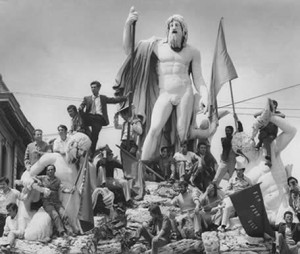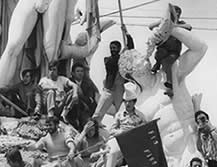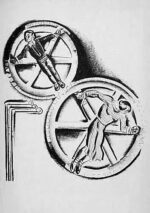Description
 Admire the fountain of Neptune symbolising the united action by the three major sheet-metal worker unions of Italy in 1971. The Fontana del Nettuno in Rome replicates the ‘triple’ theme always suggested by Neptune’s trident in the arrangement of the three mythical figures, Neptune with two accompanying Tritons. The fountain was designed by Giovanni Ceccarini and unveiled in 1825, to mark the end of a new aqueduct and the construction of the new Piazza del Popolo at the place where ancient Via Flaminia started.
Admire the fountain of Neptune symbolising the united action by the three major sheet-metal worker unions of Italy in 1971. The Fontana del Nettuno in Rome replicates the ‘triple’ theme always suggested by Neptune’s trident in the arrangement of the three mythical figures, Neptune with two accompanying Tritons. The fountain was designed by Giovanni Ceccarini and unveiled in 1825, to mark the end of a new aqueduct and the construction of the new Piazza del Popolo at the place where ancient Via Flaminia started.
Italians hear in the name of the square the concept of ‘the people’. It is, and has always been, a favoured location for political protests, although this is a false etymology: the square was named for the church of Saint Maria del Popolo, ‘of the Poplars.’ The church itself was built in 1099 to oppose the evil which people believed emanated from the location, which was the traditional site of the tomb of Nero.
The other fountain in the square designed by Ceccarini depicts the Goddess Roma, Romulus and Remus suckling the she-wolf, and the personified rivers, Tiber and Aniene.
At the beginning of June 1971, after two years of industrial unrest, more than a hundred thousand workers congregated in Rome to protest against the government’s delays in passing legislation for social reform, improved housing conditions and increased power to the trade unions. The protest was effective, and the legislation was passed later that year.
Here three unions of metal-workers, FIM (Metal-Workers’ Union of the Confederazione italiana sindacati liberi), FIOM (Metal-Workers’ Union of the Confederazione generale italiana del lavoro), and UILM (Unione italiana lavoratori), proudly pick Neptune’s fountain to announce their mutual solidarity in a photo-shoot which was published in newspapers around the globe. The flag waved on the lower right-hand corner bears all three acronyms. The following year the three unions did temporarily amalgamate and took further collective action.




